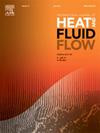涡流管能量分离机理分析及基于入口喷嘴直径的冷端孔径协同研究
IF 2.6
3区 工程技术
Q2 ENGINEERING, MECHANICAL
International Journal of Heat and Fluid Flow
Pub Date : 2025-04-26
DOI:10.1016/j.ijheatfluidflow.2025.109865
引用次数: 0
摘要
涡流管是一种结构简单的用于能量分离的机械装置,在许多领域得到了广泛的应用。涡流管的喷嘴结构对其能量分离性能有重要影响。目前的研究大多集中在确定最优尺寸参数上,很少探讨其影响机理。本文采用数值模拟的方法研究了涡流管的性能随进口喷嘴直径变化的规律,并通过流场分析了涡流管性能变化的内在机理。研究结果表明,减小进口喷嘴直径可以提高热端管附近的速度梯度和涡流强度,促进了内部流体层向外部流体层的能量传递,提高了涡流管的能量分离效率。随着进口喷嘴直径的增大,涡流管的反向流动边界向内收缩。此外,研究了进口喷嘴直径和冷端孔径对涡流管性能影响的协同关系,表明随着进口喷嘴直径的增大,存在不同的最优冷端孔径,使得涡流管性能最优。本文章由计算机程序翻译,如有差异,请以英文原文为准。
Analysis of energy separation mechanism of vortex tube and collaborative study with cold end aperture based on inlet nozzle diameter
Vortex tube, a mechanical device with simple structure designed for energy separation, is widely used in many fields. The nozzle structure of vortex tube has an important influence on its energy separation performance. At present, most studies only focus on identifying the optimal size parameters and rarely explore the influencing mechanism. This study employs numerical simulation to investigate how the vortex tube’s performance changes with variations in the inlet nozzle diameter and analyzes the internal mechanism of the above variation through flow fields. The findings indicate that reducing the inlet nozzle diameter enhances the velocity gradient and vortex intensity near the hot-end tube, promoting greater energy transfer from inner to outer fluid layers, which improves the vortex tube’s energy separation efficiency. It is also observed that the reverse flow boundary of vortex tube shrinks inward as the inlet nozzle diameter increases. Additionally, the synergistic relationship between the inlet nozzle diameter and the cold-end aperture in affecting the performance of vortex tube is investigated, which indicates as the inlet nozzle diameter increases, there are different optimal cold-end apertures, which make the vortex tube performance optimal.
求助全文
通过发布文献求助,成功后即可免费获取论文全文。
去求助
来源期刊

International Journal of Heat and Fluid Flow
工程技术-工程:机械
CiteScore
5.00
自引率
7.70%
发文量
131
审稿时长
33 days
期刊介绍:
The International Journal of Heat and Fluid Flow welcomes high-quality original contributions on experimental, computational, and physical aspects of convective heat transfer and fluid dynamics relevant to engineering or the environment, including multiphase and microscale flows.
Papers reporting the application of these disciplines to design and development, with emphasis on new technological fields, are also welcomed. Some of these new fields include microscale electronic and mechanical systems; medical and biological systems; and thermal and flow control in both the internal and external environment.
 求助内容:
求助内容: 应助结果提醒方式:
应助结果提醒方式:


